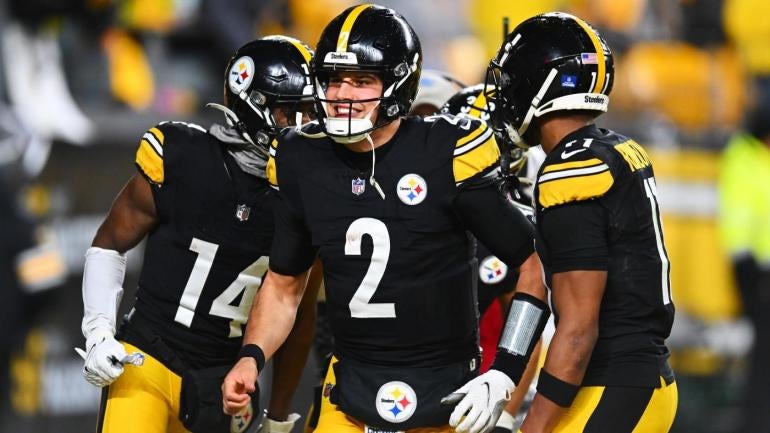
Akin to what's transpired with their orange-and-brown-clad rivals to the west in Cleveland, the Steelers' former third-string quarterback has given the offense a shocking boost of efficiency with the playoffs on the line.
In his three regular-season starts, Mason Rudolph is 53 of 71 (74.6%) for 716 yards -- that's an enormous 10 yards per attempt -- with three touchdowns and no interceptions in three wins... two of which featured the Steelers scoring 30-plus points. Those contests marked the first Steelers occasion with 30-plus points in consecutive games since October of 2020.
And much of what Rudolph's done as a passer harkens back to his time as a prodigious producer at Oklahoma State before Pittsburgh selected him in the third round of the 2018 NFL Draft.
Sample sizes matter, but all we can do now is use a two-game sample for Rudolph, and in those three starts, in which the Steelers offense has done a 180, he's attempted a pass 20-plus yards down the field on 12.2% of his throws. Before his injury, Kenny Pickett's downfield throw rate was just 9.5%.
Now, Trubisky's was almost identical to Rudolph's at 12.2%, but the former No. 2 overall pick was ghastly on those long balls, completing just 4 of 16 throws for 101 yards with one touchdown and three interceptions. Pickett was 11 of 31 for 389 yards with a score and two picks.
Rudolph's 4 of 9 for 181 yards and a touchdown.
So, why does the deep shot matter for Pittsburgh?
Anyone who's watched even a quarter of Steelers football starting last year knows the organization struck gold again in the second round with spider-web wideout George Pickens. Not getting him the ball down the field represented massive untapped potential for a struggling offense.
With Pickett and Trubisky, clearly vertical passing-challenged quarterbacks, Pickens wasn't being utilized to the fullest extent of his capabilities. It felt like a last-ditch effort do muster some spark offensively, Pickett would launch a fourth-quarter back-shoulder attempt to Pickens that would usually be hauled in, but oftentimes, that splash was too little, too late.
Pickens has accounted for all four of Rudolph's downfield completions the past three weeks.
Rudolph throws deep with a moon-ball style, giving his receivers plenty of time to field the football and adjust to it before making a play. He understands with that high-arcing trajectory that the ball has to be thrown early in the down to avoid safeties ranging to help the corner.
Take the dagger touchdown against the Bengals as a prime example:
Against the Seahawks, Rudolph demonstrated more confidence in his, I believe, slightly improved arm strength. That proved to be integral to a few deep completions to Pickens.
This was a huge connection on a third-and-6 with a four-point lead early in the fourth quarter. Nice throw; routine, awesome catch from Pickens:
And Rudolph's propensity to push the ball deep with success dates back to his college days. In his final season at Oklahoma State, he finished seventh in the nation in downfield adjusted completion rate (51.1%) among all quarterbacks with at least 50 deep-ball attempts. His 1,712 yards on long-ball throws ranked second in the nation, and his 17 touchdowns ranked third.
In two games with the Rudolph-to-Pickens rapport clicking, the Steelers have eight pass plays of 20 or more yards. Pittsburgh averaged just two of those plays in the 15 other contests this season.
Rudolph has also been surgical in the quick game, which acts as a perfect counter to the long ball. On passes made in less than 2.4 seconds, he's 28 of 37 (75.7%) for 361 yards with two touchdowns and no interceptions. He's mostly known exactly where to go with the football on underneath throws based on defensive looks.
Check out this third-and-4 conversion to Pat Freiermuth. Rudolph understood Diontae Johnson's stick route worked as a natural pick to the linebacker trying to get into the flat to cover the tight end, so he unloaded the football immediately after corralling the low snap.
There was no way the sinking Julian Love (No. 20) could get to Freiermuth in time. The result? 25-yard gain.
Rudolph's accustomed to making rapid decisions in the quick game. Fast processing on short throws was a huge component of his operation of the Air Raid offense at Oklahoma State. In 2017, Rudolph led college football with 2,544 yards on throws made in under 2.5 seconds and was second in yards per attempt (9.2).
The Steelers offense has become drastically more balanced now that there's both a serious threat of a deep play and a good chance the right decision will be made in a hurry on short, high-percentage throws. That's why they're moving the ball more efficiently (fourth in EPA per play the last three weeks).
This transformation has happened with Pittsburgh's third-string quarterback on the field. That would normally be an unbelievable development, but it's certainly not an unbelievable development in this NFL season.




















